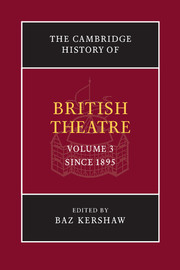Book contents
- Frontmatter
- Part I 1895–1946
- Part II Scottish and Welsh Theatres, 1895–2002
- Part III 1940–2002
- 13 British theatre, 1940–2002: an introduction
- 14 The establishment of mainstream theatre, 1946–1979
- 15 Alternative theatres, 1946–2000
- 16 Developments in the profession of theatre, 1946–2000
- 17 Case study: Theatre Workshop’s Oh What a Lovely War, 1963
- 18 1979 and after: a view
- 19 British theatre and commerce, 1979–2000
- 20 New theatre for new times: decentralisation, innovation and pluralism, 1975–2000
- 21 Theatre in Scotland in the 1990s and beyond
- 22 Theatre in Wales in the 1990s and beyond
- 23 English theatre in the 1990s and beyond
- Bibliography
- Index
- References
22 - Theatre in Wales in the 1990s and beyond
from Part III - 1940–2002
Published online by Cambridge University Press: 28 March 2008
- Frontmatter
- Part I 1895–1946
- Part II Scottish and Welsh Theatres, 1895–2002
- Part III 1940–2002
- 13 British theatre, 1940–2002: an introduction
- 14 The establishment of mainstream theatre, 1946–1979
- 15 Alternative theatres, 1946–2000
- 16 Developments in the profession of theatre, 1946–2000
- 17 Case study: Theatre Workshop’s Oh What a Lovely War, 1963
- 18 1979 and after: a view
- 19 British theatre and commerce, 1979–2000
- 20 New theatre for new times: decentralisation, innovation and pluralism, 1975–2000
- 21 Theatre in Scotland in the 1990s and beyond
- 22 Theatre in Wales in the 1990s and beyond
- 23 English theatre in the 1990s and beyond
- Bibliography
- Index
- References
Summary
There is a chilling phrase in Gwyn A. Williams’s seminal historical study of Welsh culture and identity, When Was Wales? (1985), that suggests something of the character of Welsh theatre in the late twentieth century. Baffled and disheartened by the results of the 1979 general election, which saw significant advances by the Conservative Party throughout the principality, Williams foresaw ‘the elimination of Welsh peculiarities’ and a ‘powerful simplification’ of political consciousness in Wales – a disastrous state of affairs which ‘strongly suggested an integration into Britain more total than anything yet experienced’.
By the turn of the millennium it was clear, though, that this vision of a ‘powerful simplification’ had not emerged and that rumours of the imminent death of Wales had been greatly exaggerated. Wales was not assimilated by Britain, not in the political sense at least. Rather, it clawed its way back into existence, so that the sumptuous eleven-seat Tory rump of Welsh MPs returned in 1979 had withered away to nought by 1997, and a new National Assembly for Wales – rejected by the electorate in the referendum of 1979 – convened for its inaugural session in May 1999. Williams’s fear that the Welsh political map would lose its diversity and local complexity, leading to ‘standard British two-party contests’ in most Welsh constituencies, was also misplaced. In the National Assembly elections of 1999 such constituencies were largely confined to the extreme south-east and north-east of the country. More significant still, Plaid Cymru/The Party of Wales made astonishing gains in some of the former industrial heartlands of south Wales and became the main opposition party to Labour in the Assembly, guaranteeing that the internal politics of Wales had a radically different character to those of Britain as a whole. Williams’s worries had come to nothing: quite simply, he got it wrong.
- Type
- Chapter
- Information
- The Cambridge History of British Theatre , pp. 485 - 497Publisher: Cambridge University PressPrint publication year: 2004
References
- 1
- Cited by

